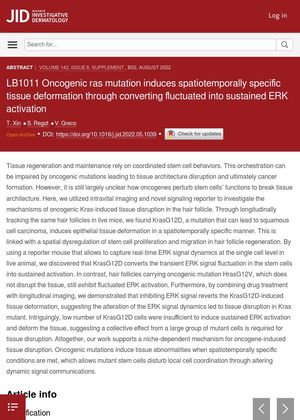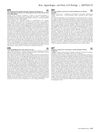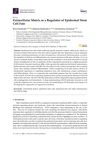Oncogenic Ras Mutation Induces Spatiotemporally Specific Tissue Deformation Through Converting Fluctuated Into Sustained ERK Activation
July 2022
in “
Journal of Investigative Dermatology
”

TLDR A specific mutation in Kras causes abnormal tissue changes by making a cell signal continuously active, which disrupts normal cell coordination.
The study investigates the impact of oncogenic Kras-induced tissue disruption in hair follicles. It was found that the KrasG12D mutation, which can lead to squamous cell carcinoma, induces epithelial tissue deformation in a spatiotemporally specific manner. This deformation is associated with a spatial dysregulation of stem cell proliferation and migration in hair follicle regeneration. The mutation was observed to convert the transient ERK signal fluctuation in the stem cells into sustained activation. However, hair follicles carrying the HrasG12V mutation, which does not disrupt the tissue, still exhibited fluctuated ERK activation. The study also found that inhibiting ERK signal can revert the KrasG12D-induced tissue deformation, suggesting that the alteration of the ERK signal dynamics leads to tissue disruption in Kras mutants. The study concludes that oncogenic mutations induce tissue abnormalities when spatiotemporally specific conditions are met, allowing mutant stem cells to disturb local cell coordination through altering dynamic signal communications.

